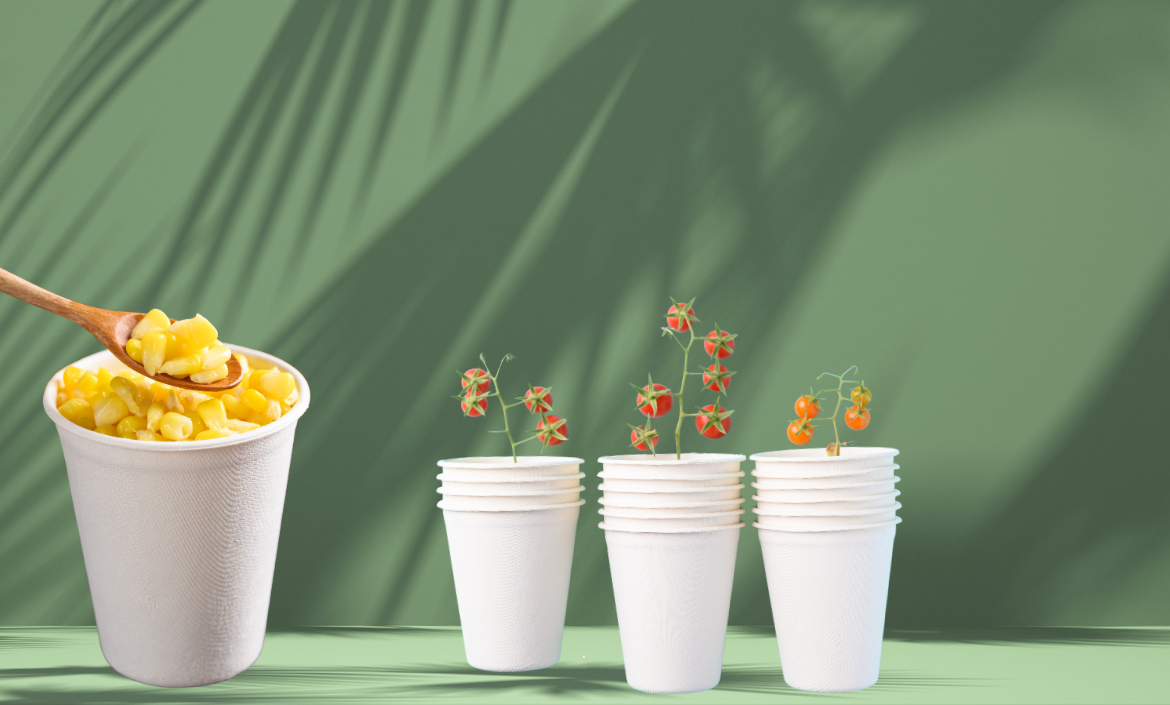Sugar cane cups: Environmental impact, pros and cons

In the world of disposable products, sugarcane cups stand out as an environmentally friendly alternative. But how green is the production and use of these products really? In this article we will discuss the environmental impact, advantages and possible disadvantages of sugarcane cups.
How are sugar cane cups made?
The production process of sugar cane cups is based on the use of agricultural waste. Sugarcane is a plant used to produce sugar, and the pulp (bagasse) left over after the sugar is extracted can be used as a raw material for products such as cups. The production process includes the following steps
Collection of bagasse:
The bagasse left over after sugar production is dried and processed.
Moulding:
The dried bagasse is mixed with various binders and moulded into cups.
Finishing:
The cups are made water and heat resistant and can usually be used without a plastic coating.
Advantages of sugar cane cups
Utilisation of agricultural waste:
Bagasse is a residual waste from sugarcane production and its use makes a positive contribution to the environment.
Compostability:
Under the right conditions, sugarcane bagasse can be composted and returned to the biological cycle.
Low carbon footprint:
Compared to plastic cups, less fossil fuel is used in the production process and carbon emissions are reduced.
Plastic free:
Sugarcane cups are generally free of plastic coatings, making them easier to recycle.
Aesthetic and durable:
They have a wide range of uses due to their stylish appearance and resistance to hot and cold drinks.
Disadvantages of sugarcane cups
Cost of production:
Sugarcane cups are more expensive to produce than plastic cups. This may be reflected in the selling price.
Composting requirements:
It needs industrial composting facilities to decompose completely in nature. Home composting conditions may be inadequate.
Agricultural pressures:
Intensive sugarcane production can put pressure on water resources and land use.
Transport emissions:
Sugarcane is often transported to areas far from production sites, which can result in carbon emissions during transport.
How environmentally friendly are sugarcane cups compared to plastic cups?
Sugarcane cups are an environmentally friendly alternative to plastic cups. However, the environmental impact of these products is not zero. For example, in areas where industrial composting facilities are not common, the recycling or composting rate of these cups may remain low. It is therefore important to consider the recycling and composting process when using sugar cane cups.
Sugarcane cups can be an important step towards a more sustainable world. However, it is very important to consider the drawbacks of these products and to use them correctly. With a use process that minimises environmental impact, these cups offer an effective alternative for both individuals and businesses. In the future, sugarcane cups may become even more indispensable as composting infrastructure improves and innovative production methods become more widespread.
What do you think about cups made from sugar cane? Do you think these are a good alternative to conventional paper cups?
Categories
- Biodegradable Products
- Blog
- Business Strategies for Eco-Friendly Growth
- Disposable Tableware
- Eco-Friendly Alternatives
- Eco-Friendly Innovations
- Eco-Friendly Living
- Eco-Friendly Packaging
- Green Business Practices
- Hospitality Trends
- Sugarcane Benefits
- Sustainability Tips
- Sustainable
- Sustainable Disposable Tableware
- Sustainable Foodservice Solutions
- Sustainable Living
- Sustainable Materials
- Sustainable Packaging
Tags
- Biodegradable Products
- Blog
- Business Strategies for Eco-Friendly Growth
- Disposable Tableware
- Eco-Friendly Alternatives
- Eco-Friendly Innovations
- Eco-Friendly Living
- Eco-Friendly Packaging
- Green Business Practices
- Hospitality Trends
- Sugarcane Benefits
- Sustainability Tips
- Sustainable
- Sustainable Disposable Tableware
- Sustainable Foodservice Solutions
- Sustainable Living
- Sustainable Materials
- Sustainable Packaging


